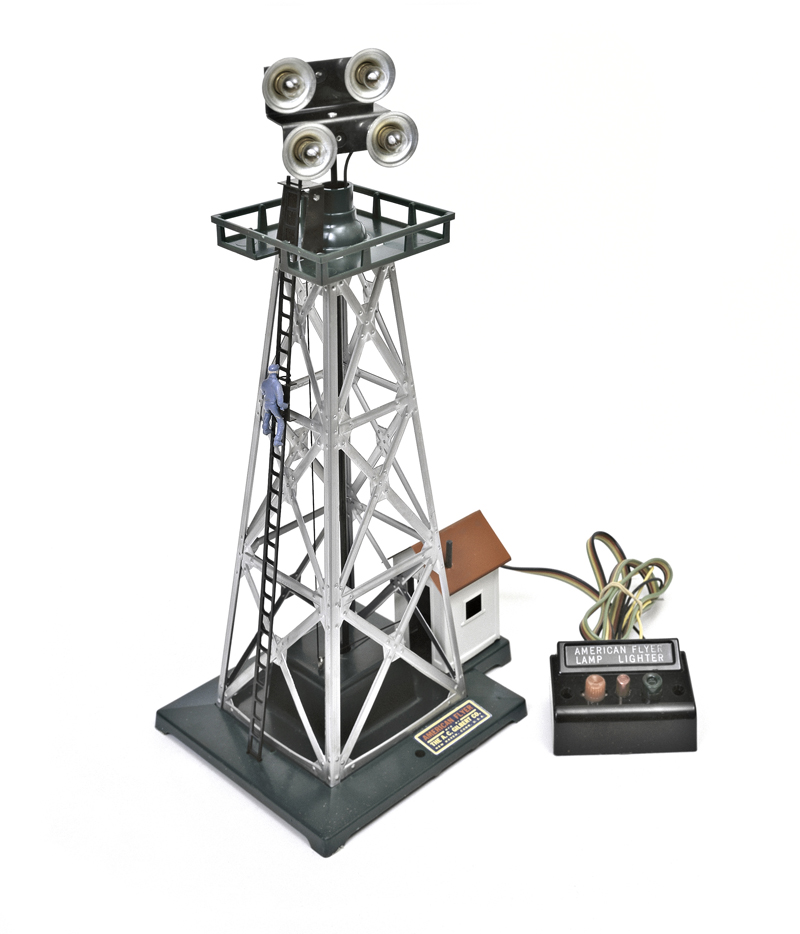Lionel wasn’t alone in making landmark accessories after World War II. Colber and Marx brought out great ones. Above all, the A.C. Gilbert Co. developed outstanding S gauge accessories for its American Flyer line. One of the most significant and collectible was the No. 23780 Gabe the Lamp Lighter.
The 23780, arguably the last great accessory developed by any American toy train maker during the postwar period, carried forward a tradition begun half a century before its debut in 1958.
Children, like all Americans at the turn of the 20th century, were fascinated by everything electrical, above all, incandescent light. Therefore, toy train manufacturers aimed to add illumination to their products: replicas of street lamps, headlights on locomotives, and interior lighting for passenger cars. Later in the prewar decades came the first of many flatcars with searchlights.
During the 1930s, Lionel offered floodlight towers. Even though none of those tall steel structures equipped with blinding bulbs returned after the war, Lionel’s engineering staff remembered the commercial advantages of cataloging them. Little wonder the company heralded in 1949 the no. 395 floodlight tower, which had four big bulbs.
As important was the No. 394 rotary beacon (new in 1949). It used heat generated by the lamp to rotate a metal housing with red and green plastic lenses. The animated effect, though not consistent, added interest to the lighting.
Gilbert sees the light

Designers at Gilbert, adamant that Lionel not go unchallenged, created the No. 769 revolving aircraft beacon to enhance the American Flyer line for 1950. Like the 394, this illuminated accessory used heat to beam its light around a room.
The next year Gilbert’s No. 774 floodlight tower enabled S gauge modelers to increase the amount of light shining on their rail yards, main lines, and stations. This popular accessory had much in common with the No. 110 tower Colber also introduced in 1951. That small company would bring out its own version of a rotating aircraft beacon in 1953 before it gave up the ghost in toy trains in 1955.
The competition among toy train producers (including Louis Marx & Co.) to build the best light tower heightened in the mid-1950s. Lionel improved its rotary beacon by replacing the heat-generated mechanism with a vibrating motor for its No. 494 (brand new in 1954). No other firm matched it. Simple floodlight towers seemed out of date, and both Gilbert and Lionel dropped theirs after 1956.
Along came Gabe
Observers might have concluded that Lionel had won the light tower sweepstakes. How wrong they were became apparent in 1958, when the American Flyer catalog showed the attractive, action-packed 23780. Credit for this ground-breaking accessory belonged to Gabe Monaco, a respected member of the engineering department at Gilbert’s factory in New Haven, Conn.
Monaco modified the 774 to develop the spectacular 23780, which the powers-that-be at Gilbert named after him. A figure stood at the based of the light tower until an operator pressed a button on the remote controller. Each touch caused little Gabe to inch up the ladder on the side of the structure, one step at a time. On reaching the green plastic platform of the 11½-inch-high tower, he appeared to switch on the two banks of lights. Then he slid down to the base.
Gilbert cataloged the 23780 for just one more year. A scarce version of this desirable accessory came with a light green plastic base. Either variation of Flyer’s classic Gabe the Lamp Lighter is a true prize.
Gilbert cataloged the No. 23780 Gabe the Lamp Lighter in 1958 and ’59.
Buyer’s checklist:
- Marred or bent tower?
- Cracked or damaged base or platform?
- Warped or broken ladder?
- Original figure?
- Scratched shed or roof?
- Missing light bulbs?
- Functioning animation (figure should go up and down)?













